Category: Uncategorized

It’s an Electronic Futures World – Now What Do We Do? The Changing Role of Brokerage
Automated execution is taking over futures markets. Actually, the battle is over. Voice (non-electronic) and manual execution are reserved for illiquid products, old school firms, smaller traders, those who may be undertaking spreads, complex legged or option strategies, roll strategies, and some block trade. However, the use of electronic trading can vary by market and sector. Technically, we are referring to manual (MAN) versus automated (ATS) trade execution where automated is generated and/or routed without human intervention. Non-electronic would be a separate category. By far, automated to automated trades dominate most markets even in many commodities. The high frequency automated traders are the new market scalpers. Financials have a higher percentage of automated trading over commodity markets.

Using Hedge Fund Pricing as a Weapon – The Firms with Scale Will Squeeze Smaller Firms
The idea that hedge funds are getting 2/20 for management fees is becoming a myth. Dynamic pricing is being used more aggressively by hedge funds with a wide range of management and incentive fee options. For example, in the managed futures space, there seems to be a willingness to offer beta products as low-cost alternatives as well as traditional alpha plus beta products. The low cost products are being marketed as trend-following beta at low cost while higher priced products are being offered as alpha generators relative to trend-following beta. Of course, there is not a clear definition for what is trend-following beta so there is something more going on with this pricing. (The beta may be associated with a peer index, so the beta firms offer a low cost product to match a bundle of competitors.) This approach is being used by a number of larger firms.

Suffering from Regret in the Hedge Fund World – A Problem for all Investors
We have learned from behavior finance that one of the key thing that investors do not want to suffer from is regret. From prospect theory, there is a desire to sell winners and hang onto losers in order to avoid regret not suffer from loss aversion. Loss aversion tied everywhere to the decisions we make. Picking the wrong manager. Picking the wrong strategy. Picking the wrong time to enter or exit a trade. Investors do want to make a decision only to find out that ex post it was a poor one.
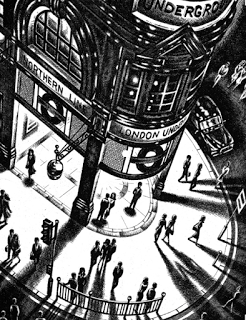
AUM Growth as a Signal of Quality – Is the Herd Right?
It is hard to determine whether one manager is better than another when looking at performance numbers. The sample sizes are often too small to distinguish return differences, so investors often looking for other signals that can be used to suggests one manager is better. One that is often used is growth of AUM. Call it the “wisdom of crowds” signal. If an investor cannot distinguish the return performance between two managers, he will place weight on the dollar opinion of others. If the herd is investing in manager X, perhaps they know something that others don’t. The investor will free ride on the due diligence of others and invest with the manager who is growing faster.

Trend-Following – A Century of Data Suggests There Is Value
Consistency is critical for any investment style or factor, and it seems that trend-following seems to show it better than most other alternative strategies. It is now almost amusing that when efficient markets ran supreme as the paradigm of choice for market behavior no one was able to find these results, but now that there […]
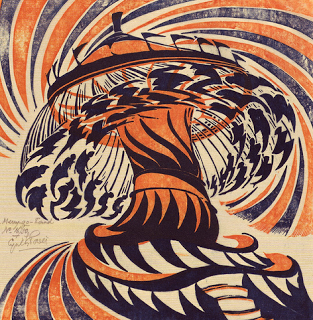
Most Stocks are Losers – Median and Skew Tell an Important Story
Most stocks do not do well over their lifetime. If you randomly pick a stock or set of stocks there is a high likelihood you will not do better than T-bills and you will likely not survive for a long time. This should be well-known, but a new research paper really present some stark conclusions. This is a paper that is insightful and sobering for most investors. See “Do stocks Outperform Treasury Bills” by Hendrik Bessembinder.
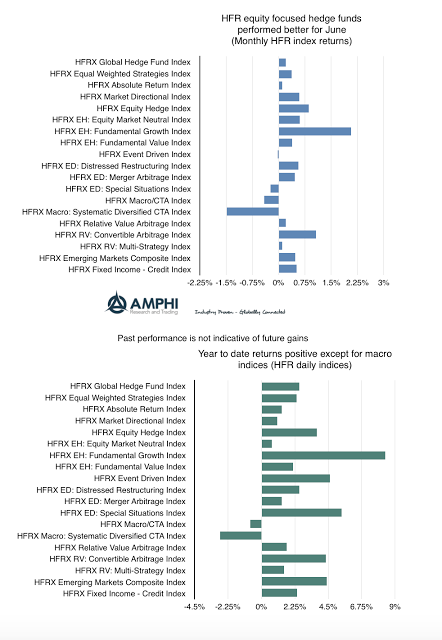
Hedge Fund Performance – Mixed from End of Month Volatility
The equity focused HFR hedge fund indices produced positive returns for the month of June while those indices focused on broad-based macro trades declined. Equity focused hedge fund managers will often do better when there is more dispersion across industry sectors and when there is stronger performance in broader-based indices like the Russell 2000. The market saw strong gains in both growth and value indices and less emphasis on large cap names. The fall in tech stocks which have been at elevated levels may also have been a contributor to some hedge fund gains.
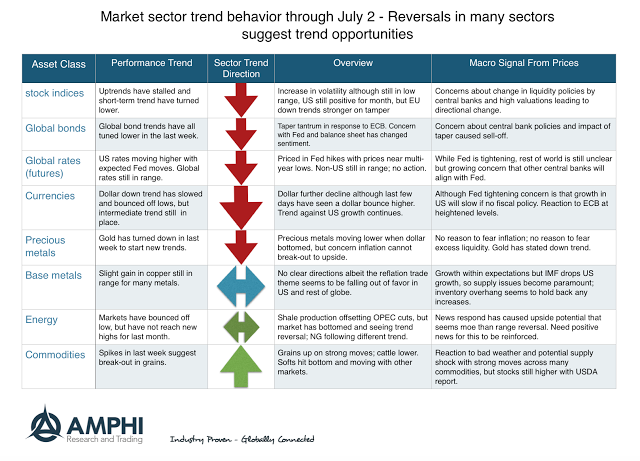
Trend Environment Looking Stronger – Loses in June May Lead to Profits in July
Trend traders were hit with a number of significant reversals in major asset classes near the end of the month. Bonds were rocked with a possible ECB “taper tantrum” albeit it is early to say that this will be like what was seen in the US. No two market tantrums will ever be the same. Equities are in a trend decline in Europe and the US has started to trend lower although the month still generated positive gains for many investors. There is an equity rotation away from large cap indices, but it is hard to take advantage of in futures. The dollar also trended lower near the end of the month only to see some gains in the last two trading sessions. Many commodities moved higher on weaker supply reports and oil products has bounced off the declines from the past few weeks. Last week was the major reversal period.
Sector Performance Mixed with Potential Roll-Over of Trends
2017 has been a risk-on year. It started with a risk-on sentiment for the US with the Trump trade and moved to a global phenomenon; however, as we end the first half of the year there is a growing level of concern across many market sectors. Short-term moving averages and break-out indicators have turned negative for a number of styles indices in June. While all major sectors except for value are positive for the year, there is the view that uncertainty and volatility may start to swamp the risk-on euphoria. Fears of over-valuation may be a topic of discussion, but money flows and price action over the last six months have told a different story.

Central Bank Communication and the “Cool Hand Luke” Effect
” What we’ve got here is failure to communicate. Some men you just can’t reach. So you get what we had here last week, which is the way he wants it. . . well, he gets it. I don’t like it any more than you men.” – Cool Hand Luke (1967) – The Captain’s speech
The last week was tough on both bond and equity markets around the globe because central bankers were trying to provide “forward guidance” to the market. Central bankers speak and the market will listen and react.
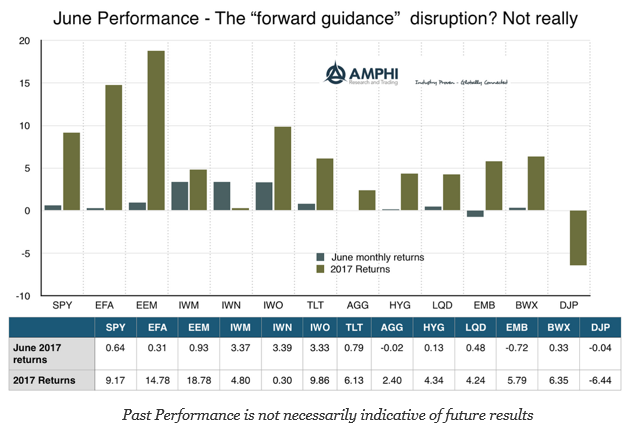
End of Month Disruption Did Not Offset Gains for Month – The Upward Path on Holiday
In spite of the market anxiety during the last week of the month, most major indices generated positive returns for June. The only exceptions were the emerging market bond index (EMB), the Bloomberg commodities index (DJP) and the Barclays Aggregate index (AGG). It was surprising that small cap, value and growth all posted strong gains after falling behind global and large cap equities. Bonds were generally positive even with the turbulence in the last week.

Diversification without Some Pain is not Diversification
“No one likes losing money, but if something in your portfolio isn’t giving you heartburn, you’re probably not diversified.” – John Lindner, PCA Consulting
How many times have you recently heard, “My hedge funds are not generating enough performance relative to my equity portfolio. Why am I holding this stuff?”
The answer is simple. It provides diversification. This diversification can be across markets, time-frames, factor sensitivities, and styles of return generation. Diversification by its very nature means that there will be performance differences and return gaps. A well-diversified portfolio will have assets that do not move together, so it should not be surprising that if an asset is added to generate diversification it will not match the core performance of equities and bonds. If performance across portfolio exposures is similar, diversification was not achieved.

Position Sizing, Expected Return, and Portfolio Results – There is Imprecision in Trader Language
This is where simple cases of imprecise language can lead to confusion. Investors may have problems with understanding what a trader means if all the assumptions concerning trading are not well-defined. Here are some questions that an investor may have when hearing the above phrases.